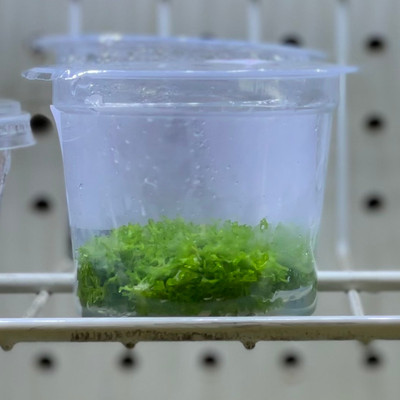Riccia fluitans Tissue Culture
Posted by Max Gandara on on 18th May 2025
Riccia fluitans Tissue Culture: A Floating Gem for Lush Aquascapes
In the aquascaping world, few plants offer the versatility and visual impact of Riccia fluitans. Often seen in nature as a floating moss, this liverwort has been embraced by aquascapers for its ability to form lush, vibrant green carpets or floating clusters. Thanks to tissue culture propagation, Riccia is now more accessible, cleaner, and healthier than ever—perfect for modern planted tanks.
What Is Riccia fluitans?
-
Type: Liverwort (not a true moss)
-
Common Name: Crystalwort
-
Growth Form: Floating or tied to hardscape/substrate
-
Light Requirement: Medium to high
-
CO₂: Highly recommended for best results
-
Growth Rate: Fast with proper conditions
-
Origin: Cosmopolitan (found on all continents except Antarctica)
Originally popularized by aquascaping legend Takashi Amano, Riccia fluitans has become a go-to plant for creating vibrant foregrounds, accenting driftwood, or adding dimension to floating plant layouts.
Why Use Tissue Culture Riccia?
Tissue culture plants are lab-grown in sterile environments, and here’s why that’s a big deal:
? 100% Pest-Free & Algae-Free
No snails, algae, or pathogens—something that can’t always be said about store-bought bunches or wild-collected Riccia.
? Healthier Starts
Strong root development and vibrant growth out of the cup thanks to the controlled nutrients in the culture medium.
? No Pesticide Residues
Tissue culture Riccia is safe for shrimp tanks and sensitive livestock right out of the box (after rinsing the medium off, of course).
How to Use Riccia fluitans in Aquascaping
1. Carpeting Plant (Foreground Use)
-
Method: Tie Riccia to flat stones or stainless steel mesh using fishing line or plant-safe netting.
-
Tips:
-
Trim frequently to keep it low and compact.
-
Ensure good lighting and CO₂ to prevent the plant from detaching and floating away.
-
Supplement with liquid fertilizers for faster, denser coverage.
-
2. Floating Plant (Natural Look or Fry Shelter)
-
Method: Let Riccia float freely at the surface or attach it loosely to driftwood tops.
-
Benefits:
-
Offers shade and helps reduce light for fish that prefer dimmer conditions.
-
Great cover for fry and small shrimp.
-
3. Hardscape Accent (Vertical Growth)
-
Attach it to driftwood or lava rocks to create “mossy” appearances or vertical textures.
-
Use glue or thread sparingly; Riccia doesn’t root, so anchoring is essential.
Ideal Conditions for Riccia fluitans
| Parameter | Ideal Range |
|---|---|
| Light | Medium to high |
| CO₂ | Recommended (20–30 ppm) |
| Temperature | 20–28°C (68–82°F) |
| pH | 6.0–7.5 |
| KH/GH | Soft to moderate |
It can survive without CO₂, but it thrives with it—producing thick, bubbly growth with visible pearling in high-tech setups.
Maintenance Tips
-
Frequent Trimming keeps it from becoming too buoyant or shading lower plants.
-
Secure Re-tying may be needed as growth lifts older portions.
-
Watch for Debris—Riccia can trap waste, so keep your flow and filtration optimized.
Fun Fact
Though it looks like moss, Riccia is a liverwort, an ancient lineage of plants older than ferns or flowering plants. In nature, it grows in nutrient-rich water bodies and can even form floating mats in rice paddies!
Conclusion: Why Choose Tissue Culture Riccia fluitans?
Whether you're creating a lush foreground carpet, a floating haven for fry, or simply adding vibrant texture to your aquascape, tissue culture Riccia fluitans is the cleanest, safest, and most effective way to start.
Its adaptability, stunning coloration under good light, and dynamic growth pattern make it a must-have for aquascapers who love both beauty and control.
✅ Pro Tip:
Pair Riccia with other carpeting plants like Monte Carlo or Eleocharis to create layered texture, and use it around rock bases for that signature “Amano-style” natural look.

